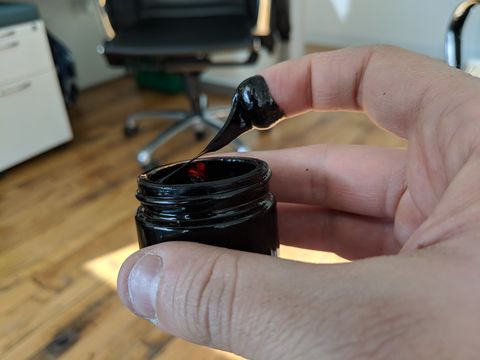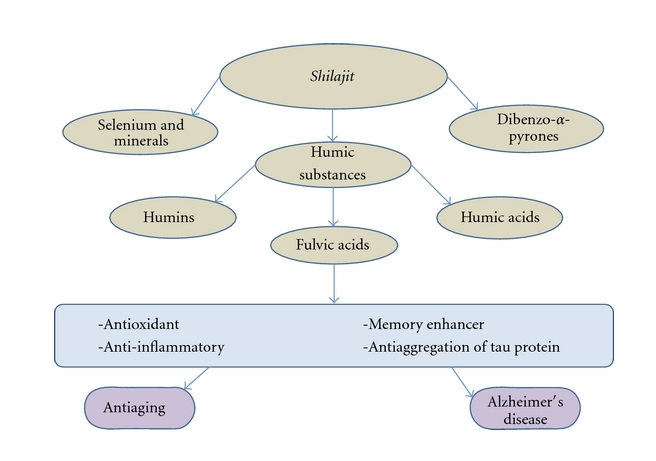Shilajit is a tar-like sticky black substance found mainly in mountainous regions. It is primarily found in the Himalayas and is vastly popular in South Asia.
Shilajit has a range of benefits associated with it. It is quite famous for its boosting effects on male sexual wellness and fertility.
You can see the dark color and tar-like texture of Shilajit in the following picture:

The texture and color of the unfinished Shilajit are not necessarily the same as the finished product. Mostly, Shilajit supplements are black, but they are found in both liquid and pills. There are also powdered forms of Shilajit available in the market.
Where is Shilajit Found?
Shilajit has been made naturally for several hundred years. It is a product of the slow decomposition of plants in the mountains, where the decomposing plants merge with various minerals to make the tar-like substance. This is why it is also known as mineral pitch.
It is mainly sourced from the Himalayan Mountains range of Pakistan and India. It has also been traditionally extracted in Tibet.
While these are the traditional sources of Shilajit, it has recently been discovered in the mountain ranges of other countries as well.
Molecular Composition of Shilajit
Humic substances make up the main component of Shilajit.
The most prominent humic substance in Shilajit is fulvic acid. It accounts for 60-80 percent of all nutraceutical compounds. Furthermore, selenium and other oligoelements with anti-aging properties are also found in Shilajit.
The following figure shows a detailed representation of the molecular composition of Shilajit.

These humic substances are formed due to organic matter decay over many centuries. Many microorganisms have been involved in the process of making Shilajit over the years.
The three major components of Shilajit are fulvic acids, humic acid, and humins. Fulvic acid is water soluble at different pH conditions, unlike humins that don’t dissolve in water at any pH level. Humic acid is only water-soluble when the conditions are alkaline in nature.
The various benefits associated with Shilajit might be because of the high levels of fulvic acids present in the substance. Since fulvic acid is a strong antioxidant, it can lead to a range of benefits and reduced risks of several diseases.
Recent studies have shown that the chemical composition of Andean Shilajit from Chile shows evidence of 50-500 Trolox units/g at the ORAC index score. That is why Shilajit can be termed as a strong antioxidant phytocpomplex.
Benefits of Shilajit
Shilajit has been part of several ayurvedic treatments for many hundred years. It has also generated a lot of interest in the research community as a supplement for several ailments.
Many studies have been done to explore the benefits of Shilajit. Some of the most prominent benefits of Shilajit are discussed as follows.
Brain Function
Shilajit contains a number of compounds that might help improve the brain function of those struggling with memory issues or degenerative diseases of the brain, such as Alzheimer’s disease.
A research study on the precognitive activity of Shilajit was published in the year 2012. The study explained that one of the traditional use of Shilajit was to slow down the aging of the brain. The study has shown great potential for Shilajit in improving brain function but suggests that more research be done to study this relationship.
As mentioned before, Shilajit contains a high amount of fulvic acid, which happens to be a strong antioxidant. The reason that Shilajit can be helpful in improving cognitive health is because of its propensity to lower the accumulation of tau protein.
Tau proteins can be vastly beneficial for the body, but if they accumulate in large amounts, they can also be harmful to the nervous system. Experts believe that the inhibiting effects of Shilajit on tau protein are significant in improving brain function and improving the symptoms of Alzheimer’s disease.
Even though Shilajit shows a lot of promise for the improvement of brain function, a lot more research is needed to establish a concrete connection between Shilajit and brain function.
Male Fertility and Low Testosterone Levels
A lot of men face fertility issues because their body does not produce testosterone, a key hormone needed for healthy sexual function.
When testosterone count is low in a male body, it exhibits itself in the form of various symptoms such as fatigue, hair loss, higher body fat, lower sex drive, and loss of muscle mass.
Shilajit has been used as a cure for a lot of these issues as per traditional ayurvedic medicine. Many scientific studies have been carried out in order to validate these findings.
One such study examined the role of Shilajit as a male fertility drug. In this placebo-controlled experiment, the impact of 100 mg Shilajit was studied. The study comprised a total of 60 men, divided into the experimental and control group. The former received the prescribed dose of 100 mg everyday while the latter received only a placebo.
The results showed a significant increase in the quality of the sperm. It also showed that the participants who took Shilajit had an improved sperm count than the control group, on average.
The study showed that Shilajit could be an effective supplement to improve sperm count in men who struggle with this issue. Furthermore, improved sperm quality is also likely to reduce male fertility issues.
Another placebo-controlled, double-blind study was conducted in 2015. It also explored the impact of Shilajit on testosterone levels in men. The comprised of participants were 45 to 55 years of age. Half of the participants received 500 mg per day doses of Shilajit, while the other half were given a placebo.
The results of the study showed remarkable improvements in the testosterone levels of the experimental group after the duration of 3 months. The study showed that Shilajit could be a potential booster drug for testosterone and help resolve the fertility issues that stem from low testosterone count.
The results also reported elevated levels of testosterone precursor DHEA. Furthermore, the levels of FSH and LH (gonadotropic hormones) were also significantly increased for the experimental group as compared to the placebo group.
Chronic Fatigue Syndrome
Another way Shilajit has the potential to make a significant contribution toward overall health and fighting ailments is in the fight against chronic fatigue syndrome (CFS).
CFS can be highly debilitating and damaging to the life quality of an individual because it negatively affects all avenues of their life. It can make even the most basic tasks – such as going to work or doing household chores – seem tedious.

CFS can occur for a variety of reasons, but one of the most prominent reasons it happens is impaired mitochondrial function. Mitochondria are charged with energy production in the cells. When mitochondria don’t function as intended, the overall energy available to the body declines, and the person experiences fatigue.
Evidence suggests that Shilajit could be helpful in fighting chronic fatigue by improving the overall mitochondrial function in the cells. How Shilajit helps improve mitochondrial function is not entirely clear.
Dinesh Surapaneni conducted an animal study with his team in 2012 that explored the impact of Shilajit on rats surfing from CFS.
The study showed that the Shilajit was able to reverse all the behavioural symptoms of CFS in the rats under study. It also prevented mitochondrial dysfunction in the rats that are induced as a result of CFS through the stabilization of activities of complex enzymes.
The researchers show good potential for treating CFS through Shilajit but insist that further detailed studies are needed to establish the connection. Further studies are also needed to explore how Shilajit impacts the mitochondrial function impaired due to aging.
Anemia
Anemia is a condition where the oxygen supply to the body’s tissues is restricted because the number of healthy red blood cells in the body is not enough.
There are many causes of anemia, including blood loss, trouble absorbing iron, and a diet distinctly low in iron. If you have anemia, you may experience the following symptoms:
- Cold hands
- Cold feet
- Headache
- Fatigue
- Irregularity in heartbeats
Shilajit supplements can help improve the iron levels of the body.
According to a study published in the year 2010,
A 2010 study by Chinnasamy Velmurugan and his team conducted an experiment to examine the impact of Shilajit supplementation on anemic rats. They made 6 groups of a total of 18 rats and induced anemia in two of the groups. Between these two groups, they gave Shilajit to one group for 21 days.
After that, the researchers measured several blood markers in all of the groups, such as red blood cells, hematocrit, and haemoglobin levels. The rats who received Shilajit supplements scored better for all three blood markers.
Further research is needed to establish a connection between Shilajit treatment and the reduction of anemia.
Cardioprotective Effects
Another important area where Shilajit can be helpful in cardiovascular health.
A 2014 animal study conducted by Siyavash Joukar and their team looked into the impact of Shilajit on protecting the heart from further damage after experimentally induced myocardial injury.
Rats were divided into three main groups: one control group and two experimental groups, each receiving 250 and 500 mg doses of Shilajit, respectively. These main groups were further divided into two sub-groups: those with and without myocardial injury.
The rats that received Shilajit showed significantly less damage to the heart as compared to those in the control group.
Aging

Picture by Matthias Zomer at Unsplash
As previously noted, Shilajit has a strong tendency to improve mitochondrial function in the cells. This activity may have anti-aging effects.
One of the hallmarks of aging is poorer mitochondrial function. So it stands to reason that if the overall mitochondrial decay was managed, aging could also be slowed down.
Other than that, the fact that Shilajit has an abundance of fulvic acid also makes it a strong contender for an anti-aging supplement. The antioxidant and anti-inflammation actions of Shilajit may contribute to lowering free radicals’ accumulation, thus helping in the prevention of cellular damage.
Some studies have pointed towards various anti-aging benefits of Shilajit. It has shown promise in slowing down the aging process, bettering the health span, and increasing longevity.
More research is needed to study the anti-aging properties of Shilajit in further detail.
Interactions and Safety Concerns of Shilajit
For the larger part, Shilajit is considered safe in supplemental form. There are harmful side effects when the substance is consumed in raw form, but supplements can be mostly harmless. Since raw Shilajit contains various contaminants such as heavy metal ions, fungus, and free radicals, it can be bad for your health.
It must also be noted that you should only buy Shilajit supplements from trusted companies that have third-party testing certificates readily available because supplements are not regulated by any Federal authority in the United States.
If you have any of the following conditions, you should avoid taking Shilajit:
- Hemochromatosis
- Thalassemia
- Sickle cell anemia
Furthermore, if you notice a rash or experience increased heart rate or dizziness, you might be allergic to Shilajit. You should stop taking the supplements and go to the emergency room if the condition turns serious.
If you have an active heart condition, you should also avoid taking Shilajit because it may severely reduce blood pressure for some people.
Frequently Asked Questions
Following is a list of the most frequently asked questions about Shilajit.
1. What is the recommended dosage of Shilajit?
The “correct” dosage of Shilajit depends upon the reason behind your supplementation. Usually, 300 mg to 500 mg doses are recommended, but you might want to consult your doctor about it if you are unsure.
Studies have shown Shilajit to be safe for consumption at up to 500 mg per day.
2. How should I take Shilajit supplements?
Since Shilajit supplements come in many forms, you have the freedom to choose the mode of delivery best suitable to your taste.
Many people take Shilajit by dissolving a small amount of liquid Shilajit (a “pea-sized” amount is recommended) in a liquid of their choice and drinking it three times a day. Some people also take powdered Shilajit with milk.
There is not much of a difference in the safety and efficacy of Shilajit in powdered and liquid forms. It depends upon what you personally prefer.
3. Should I be aware of any side effects of these supplements?
Shilajit has been widely regarded as a safe supplement for long-term use, provided that you do not take it in raw form. Research studies have proven that most people taking supplements do not exhibit any serious side effects.
People taking medicines for high blood pressure can experience side effects from the consumption of Shilajit. It is generally recommended not to take supplements if you have such a condition. People with hypotension and active heart disease should also be careful and consult their doctors before they decide to take it.
Adverse side effects only surface when the quality of Shilajit supplements is particularly low. The heavy metal ions and free radicals can do significant damage to the internal organs of the body.
You would do well to only source Shilajit from reliable companies.
